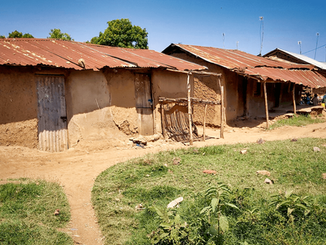
Mageta Island
Lying off the eastern shores of Lake Victoria adjacent to Siaya County, Mageta Island is about 8km from end to end and about one kilometre wide at its widest. Its total surface area is around 6.6 square kilometres. It is located in Bondo district, one of the poorest districts in Kenya.

The main economic activities are fishing and small-scale subsistence farming.
Mageta Island has some of the highest HIV and AIDS prevalence and child mortality rates in Kenya.
Mildmay has been working with communities to deliver HIV-healthcare through support, education and training in remote, impoverished rural areas like Mageta in Western Kenya for over 20 years.
Despite social, economic and political advances elsewhere in Kenya, the island community feels isolated and there is little development in infrastructure, health and education. The island is not connected to the electricity grid and inefficient solar power cells generate barely enough power to light 40w light bulbs.
Residents say it is too expensive to invest in the island since everything, apart from water and fish, has to be imported from the mainland. Those who have good houses have spent a fortune importing cement, roofing materials, sand and nails to put up the structures.
The lack of availability of economic resources and education is pushing most inhabitants of Mageta Island to follow traditional practices, which include wife inheritance, early marriages among girls leading to dropouts from school and risky sexual behaviours such as “sex for fish” in which female traders engage in sexual relationships with fishermen to secure their supply of fish, leading to sexually transmitted diseases.
The island is home to over 12,000 people, 24.8% of whom are living with HIV. taken around the island as a mobile treatment centre.
Maternal mortality exceeds the national average by 42% and half of these deaths occur after delivery. This area of Western Kenya also contributes to over 70% of new HIV infections in children.
Health, in general, is not as good among the island communities compared to the country as a whole. Mosquitoes and tsetse flies are abundant, spreading diseases like malaria and yellow fever. Tuberculosis is also widespread.
Travelling across the Island to access healthcare is challenging as there are few roads - just tracks, effectively, difficult terrain and severely limited transport options (there are no cars in the island).
To help, Mildmay purchased a Tuk-tuk ambulance in 2018 to significantly improve access to maternity care for pregnant women, protecting their lives and those of their unborn children, as well as helping to prevent the transmission of HIV from mother to child. When the ambulance is not being used for emergencies, it is taken around the island as a mobile treatment centre.


Background
During the 1952–1960 Mau Mau Uprising, the British colonial government used Mageta Island as a forced labour and detention camp due to its isolation in inhospitable territory.
The detention cells were later converted into the health facility that now serves the whole island, established by the national government before the devolution of power and responsibilities to county governments in 2010.
Devolution has resulted in a sporadic and continuous health crisis in Kenya since the allocation for health is mostly for recurrent costs.
There is also an ongoing problem with drug supply and investment in facilities.
Image credit: IWM MAU 865






